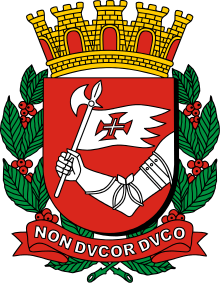Trens Intercidades
Trens Intercidades (TIC) is a four line regional rail network proposed by the government of the State of São Paulo in Brazil, linking the city of São Paulo with Jundiaí, Campinas, São José dos Campos, Sorocaba and Santos.[2]
| Trens Intercidades | |||||||||||||||||||||||||||||||||||||||||||||||||||||||||||||||||||||||||||||||||||||||||||||||||||||||||||||||||||||||||||||
|---|---|---|---|---|---|---|---|---|---|---|---|---|---|---|---|---|---|---|---|---|---|---|---|---|---|---|---|---|---|---|---|---|---|---|---|---|---|---|---|---|---|---|---|---|---|---|---|---|---|---|---|---|---|---|---|---|---|---|---|---|---|---|---|---|---|---|---|---|---|---|---|---|---|---|---|---|---|---|---|---|---|---|---|---|---|---|---|---|---|---|---|---|---|---|---|---|---|---|---|---|---|---|---|---|---|---|---|---|---|---|---|---|---|---|---|---|---|---|---|---|---|---|---|---|---|
| Overview | |||||||||||||||||||||||||||||||||||||||||||||||||||||||||||||||||||||||||||||||||||||||||||||||||||||||||||||||||||||||||||||
| Type |
| ||||||||||||||||||||||||||||||||||||||||||||||||||||||||||||||||||||||||||||||||||||||||||||||||||||||||||||||||||||||||||||
| Locale | |||||||||||||||||||||||||||||||||||||||||||||||||||||||||||||||||||||||||||||||||||||||||||||||||||||||||||||||||||||||||||||
| Termini | Palmeiras-Barra Funda Americana | ||||||||||||||||||||||||||||||||||||||||||||||||||||||||||||||||||||||||||||||||||||||||||||||||||||||||||||||||||||||||||||
| Stations | 24 | ||||||||||||||||||||||||||||||||||||||||||||||||||||||||||||||||||||||||||||||||||||||||||||||||||||||||||||||||||||||||||||
| Services | 4 | ||||||||||||||||||||||||||||||||||||||||||||||||||||||||||||||||||||||||||||||||||||||||||||||||||||||||||||||||||||||||||||
| Daily ridership | 60,000 (projected - São Paulo to Americana section)[1] | ||||||||||||||||||||||||||||||||||||||||||||||||||||||||||||||||||||||||||||||||||||||||||||||||||||||||||||||||||||||||||||
| Operation | |||||||||||||||||||||||||||||||||||||||||||||||||||||||||||||||||||||||||||||||||||||||||||||||||||||||||||||||||||||||||||||
| Planned opening | Unknown | ||||||||||||||||||||||||||||||||||||||||||||||||||||||||||||||||||||||||||||||||||||||||||||||||||||||||||||||||||||||||||||
| Technical | |||||||||||||||||||||||||||||||||||||||||||||||||||||||||||||||||||||||||||||||||||||||||||||||||||||||||||||||||||||||||||||
| Line length | 477 km (296 mi) | ||||||||||||||||||||||||||||||||||||||||||||||||||||||||||||||||||||||||||||||||||||||||||||||||||||||||||||||||||||||||||||
| Track gauge | 1,600 mm (5 ft 3 in) | ||||||||||||||||||||||||||||||||||||||||||||||||||||||||||||||||||||||||||||||||||||||||||||||||||||||||||||||||||||||||||||
| Operating speed | 160 km/h (99 mph) | ||||||||||||||||||||||||||||||||||||||||||||||||||||||||||||||||||||||||||||||||||||||||||||||||||||||||||||||||||||||||||||
| |||||||||||||||||||||||||||||||||||||||||||||||||||||||||||||||||||||||||||||||||||||||||||||||||||||||||||||||||||||||||||||
Background
In 2010, São Paulo state government showed off a project to build up 4 regional intercity trains routes connecting the area surrounding São Paulo with high population cities close by,[3] which today rely exclusively on intercity buses that are almost completely saturated and running at absurdly short intervals at full capacity. The original plan was for construction to start 2013–2014, but the Brazilian financial crisis that it is suffering since 2015 has put all projects on standby, and the next prediction is for construction to start only by 2020. In 2016 the Brazilian government confirmed it was seeking South Korean assistance with the development of a São Paulo regional rail network[4] and in 2019, the cost was estimated at Rs 20 billion.[5]
Lines
Sao Paulo to Sorocaba
The first line will depart from Água Branca interchange station in São Paulo and go to Sorocaba, a 500.000 inhabitants city about 100 km west of São Paulo, stopping at Sao Roque and a populous neighbor of Sorocaba, Brigadeiro Tobias in the way. The complete journey will take around 50 minutes
Sao Paulo to Santos
The second line will depart Sao Carlos interchange station in São Paulo and head to Santos, a 430.000 inhabitants city 50 km south of São Paulo in the coast, which an important beach town as well as Brazil's most important freight port. The train will stop in 2 cities on the way. The complete journey will take around 35 minutes.
Sao Paulo to Campinas and Americana
The third, and probably the most important and urgent line, is the line connecting São Paulo Agua Branca interchange station to Jundiaí, Campinas and Americana. Campinas is one of Brazil's largest regional centers, it is just 90 km north of São Paulo, and has its own Metropolitan area with over 3 million inhabitants, Jundiaí is a 400.000 inhabitants city in between them, and Americana is a 200.000 inhabitants city in the north limit of Campinas metro, the journey from São Paulo to Jundiai will take 20 minutes, to Campinas around 40 to 50 minutes and Americana just over an hour.
Sao Paulo to Sao Jose dos Campos
The fourth route will leave Penha intermodal station and head to Sao Jose dos Campos, a 710.000 inhabitants city 100 km east of São Paulo, which is a very important tech center, with the headquarters of Embraer, for example, two universities public and various private, and also with large industrial complex, operating automotive, military, chemical and metal-mechanical industry.
Other routes
There are also future plans for other important routes from Sorocaba to Paulinia, Campinas to Piracicaba and Campinas to Rio Claro.
References
- "When can São Paulo expect its $8.5 billion inter-city rail network to arrive?". Smart Rail World. 3 April 2017. Retrieved 29 April 2019.
- http://www.aeamesp.org.br/wp-content/uploads/2017/11/Apresenta%C3%A7%C3%A3o-Trens-intercidades-Secret%C3%A1rio-Clodoaldo-Pelissioni.pdf
- "Trens Regionais". www.stm.sp.gov.br. Archived from the original on 15 September 2016. Retrieved 31 August 2016.
- "Korea to support São Paulo regional rail study". Rail Professional. 18 February 2016. Retrieved 29 April 2019.
- "São Paulo targets rail expansion". Rail Journal. 2 January 2019. Retrieved 29 April 2019.
